


Summer 2006, Vol. 10, No. 2 Jody Georgeson, EDITOR
Contents
Director's ReportCorrection: THG Board of Directors 2006
In Memory
The Last of the Bell System Palaces--A Virtual Tour
Museum of Communications
A Snapshot of THG, Part II
The Call Box Caper, Part One, 1995
What Is This?
Director’s Report
By Jody Georgeson
Whew! It's been a very busy spring here at THG. We're putting the finishing touches on the "Virtual Tour" and learning kit of the 931 14th St. building. We'll be testing it with teachers, students, and other users during the summer, and will be making adjustments and additions.
On "Bring your Child to Work Day" at Qwest, we hosted four tours of ten kids and ten parents. We also had a group of fourth-graders from Stanly British Primary School. We love kids here, so if you're looking for a fun activity with your children or grandchildren this summer, please give us a call.
Herb has led several tours of the Alan True murals at 931 14th St., including a Public Art tour sponsored by the University of Denver. The program included the Colorado Convention Center (especially the Big Blue Bear), the Convention Center Hotel, the Ellie Caulkins Opera House, and our murals. You see what good company we're in!
Speaking of the murals, Qwest has recently had them cleaned. They were restored in the early 1980s, and are in remarkably good shape for art that is exposed to the great outdoors. The display cases on first floor at 1005 17th St. in Denver got a good cleaning, too, thanks to the volunteers and the Qwest building maintenance folks. They look great!
All this brings me to my point-- please come see all of our wonderful collections. Thanks to many of you, we have tons of documentation and artifacts that illuminate our fascinating telecom history. Thanks to Qwest, we have a beautiful historic building as a showcase for that history. If you can't make it to our facilities, then please try out our virtual tour--I think you will find it interesting, educational and fun.
We have a couple of new faces at the office in Denver. Marty Donovan has a background in computer science administration. She'll be keeping our administrative functions (bill payment, invoices, monthly reports, etc.) up to date. We have also hired an accountant, Wayne Roszelle, to keep us on the straight and narrow financially. Wayne owns and operates Centennial Business Systems. I am very thankful to both for all their help!
Correction: THG Board of Directors 2006
When listing the members of the Board last issue, I inadvertently left out Director Emeritus Robert Runice. Bob was instrumental in the formation of The History Group in 1992, and served as its president for several years. Bob worked tirelessly for the good of THG until his retirement from the Board last year. We have been fortunate and privileged to work with him.
In Memory
THG has lost two good friends and members this quarter. Karen Sampson wrote to let us know that her dad, Jim Sampson of Rock Island, Illinois, had died. Jim had a marvelous collection of telephone equipment, much of which we were given when Herb and Curt went to visit Jim in 2001. Since then, we have continued to receive photographs, spare parts and other memorabilia from Jim and Karen.
Jim was a self described "professional safety engineer, safety director, historian, church member, collector and citizen." He was also a heck of a nice guy, and will be greatly missed.
Dick Bendicksen, a retired volunteer at The Museum of Communications, passed away late in April. Dick was our "Toll/Telegraph" expert and, along with his wife Beverly who died a couple of years ago, was totally involved in building the museum to its current splendor. The Seattle branch of the THG family misses both very dedicated volunteers.
The Last of the Bell System Palaces--A Virtual Tour
 We are excited and proud to announce an Internet tour of the 1929 MST&T headquarters building at 931 14th St. in Denver, on-line as of June 30. This building was recently added to the National Register of Historic Places, but because it is still a working central office, it is largely unavailable for public viewing. Funded in part by a grant from the Colorado State Historical Fund, we have developed a virtual tour of this fabulous "Bell System Palace" in order to share it with others.
We are excited and proud to announce an Internet tour of the 1929 MST&T headquarters building at 931 14th St. in Denver, on-line as of June 30. This building was recently added to the National Register of Historic Places, but because it is still a working central office, it is largely unavailable for public viewing. Funded in part by a grant from the Colorado State Historical Fund, we have developed a virtual tour of this fabulous "Bell System Palace" in order to share it with others.
Learn why and how the building was built; listen to interviews with people who worked in and visited the new building; see the beautiful Alan True murals that grace the main floor. We have included activities for children (and those of us who have never stopped being children) and suggested lesson plans for teachers.
We have also put together a "learning kit", a box full of artifacts, games and activities for use in teaching history to children in grades 4 through 8. This kit will be available for schools to borrow beginning in the fall of 2006.
All this and more can be seen at www.telcomhistory.org/vm.
"Backward is just not a natural direction for Americans to look—historical ignorance remains a national characteristic." --Larry McMurtry, American author, 1936-
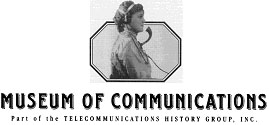
Museum of Communications
By Don Ostrand
Our "Self-guided" Tour
The museum received an anonymous gift to purchase equipment for a self-guided tour of the museum. We purchased 15 handheld audio players from Audio Antenna Company and the software to program these devices. After preparing the script for the second floor, a professional recording was made and has now been loaded on the players. Individual "tracks" tell the story by keying in the numeric(s) we have posted at various points-of-interest throughout the second floor. Feedback from museum visitors is very favorable. The comments are that the texts are "short and sweet" and that visitors can select and view items of their interest, without needing a docent to conduct a tour of the whole floor.
The text for the third floor is in editing at this time. The technical equipment is more difficult as the typical visitor's level of knowledge must be considered. We have determined that dual recordings for some parts of the tour will be used to allow a deeper technical insight by selecting a second track. This is progressing quite well. We have a target for completion of the third floor by the end of September.
The addition of the self-guided tour will greatly enhance the visitors' experience at the museum. Our docents will still be available to answer questions and demonstrate the working displays.
We feel very grateful for the gift that makes this program possible.
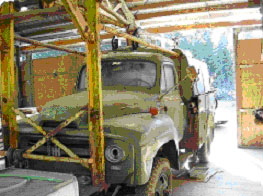 The Line Truck
The Line Truck
During the winter "off season" we have successfully duplicated the wiring harness and are ready to install it. The brake drums have been sent out for repair and should be returned within a couple of weeks. The weather will now allow us to renew our restoration efforts and make the truck ready for display at the museum. More on this project as time goes on.
A Snapshot of THG, Part II
By Herb Hackenburg
In the last issue of Dial Log, I did a written snapshot about half of the THG volunteer force--you know, “…who they are and what they do in 100 words or less.” Now it’s the other half’s time in the Dial Log spotlight.
Norman Birt started with THG as a volunteer intern. While he and his family live in Longmont, Colorado, he attends college in Emporia, Kansas, via distance learning. He is a Master of Library Science candidate, and plans to become an archivist. From what we’ve seen he’s going to be a darn good one. Norm began by inventorying our audio tapes (mostly Mountain Bell and Northwestern Bell radio ads); to do this he had to listen to hundreds of tapes and enter their subject matter into our database. His next job was processing our flat file collection —blueprints, large photos, scrapbooks and posters. He recently completed a practicum (a more formal sort of internship) at the National Archives and Records Administration here in Denver, and is back at work on the flat files.
Renee Lang began volunteering at THG while she was still working full time at U S WEST/Qwest. Renee's a real go-getter, and can often be found setting up new exhibits and cleaning and/or redecorating the archives. Renee has worked extensively with the photo collection and associated databases, and has a real knack for organization. She helps us keep our collection in order, and picks up after us when we've "rummaged" in the files.
Bob and Annetta Haack (our telecommuting volunteers from Arizona) continue to index periodicals from Northwestern Bell. They have completed a database of the Northwestern Bell Magazine (1928-1965), which will allow researchers to search by article title, subject, author name, employee name, or location. This is an enormous achievement--especially since Bob reports that he had to stop and read many of the articles about friends and acquaintances.
Mary Riffle began her telephone career in 1978, in Mountain Bell’s Public Relations Department. Mary and I became good buddies at that time and are still buds today. In the 1970s, the PR department left a lot to be desired when it came to practicing the “teamwork” it promoted to the other MB departments. I lasted until 1990 (MB became U S WEST in 1984); Mary hung in until 2004 (U S WEST became Qwest in 2000.) Mary’s professional work product is currently one of the larger collections in the THG archive. After I retired as Executive Director of THG, Mary took that job. One of her responsibilities was to find funding. She gained a significant grant from the Colorado Historical Fund. Grandmother duties and singing (mezzo-soprano) grew in importance, so Mary became a THG volunteer and Jody Georgeson became the THG Executive Director/Archivist. Mary is following through with the Historical Fund project until it’s completed.
Roy Lynn was one of the “good guys” in the 1970s Mountain Bell PR Department when he was a TV engineer, along with fellow good guys Ron Pickins and Bob Cook (one of the original three THG volunteers, he no longer lives in Denver). Roy and his friend Milo (next paragraph) are unique THG volunteers in that they repair 100-year-old magneto telephones for the U S Forrest Service in Montana. They ride horses into a wilderness area and repair the phones on a working 45-mile line. Last year it was a ten-day (and night) job. They plan to go back this year.
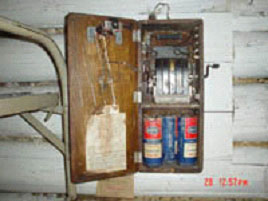
Ranger's phone at Basin Creek
camp in Montana.
Milo Masura worked with Roy in the Qwest “radio shop” in the Mineral building in Littleton, Colorado. It was more microwave than radio but they worked together; Milo only spent a short time in the telephone business. Milo always has a smile and a knack for designing and building specialized tools to do atypical jobs, such as a universal portable test set for magneto phones. Today, when Milo isn’t volunteering for THG, he’s driving an 18-wheeler across the nation.
Beth Trudgeon is the daughter of a well-known and respected Mountain Bell telephone engineer, Francis Trudgeon. Following the footsteps of her father, Beth volunteers for a host of Denver organizations including THG. She helps me file news clippings of modern telephone history being made around the world. Beth’s father designed and made the first “gouged out lettering on a thick plank” landmark identification signage now used by the National Park Service.
Merlin Creason has been my good friend and Wednesday morning coffee- drinking buddy for the past two decades. We attend Rockies games together. A graphic artist, Merlin designed the THG and Telecommunications Museum letterheads and volunteer shirts we all wear. Merlin is THG’s “long trip to pick up stuff” volunteer. Merlin and I have driven rental trucks to Salt Lake City and Cedar Rapids, Iowa, to pick up loads of antique telephone equipment and historic goodies. (We found time to see the Salt Lake Bees play some baseball while we were in the neighborhood.) Merlin also got soaked while helping us save our directory collection during our most recent flood at the archive. It was his second time for that unpleasant duty.
Herb Hackenburg--I sort of started this thing. Soon after the history of Mountain Bell was published, my research assistant Anne Hampton and I suggested to upper management that some sort of “archive of last resort” be established. During our tours around the company doing research and interviews for the book we saw thousands of telephone artifacts and published material being hauled to the local landfills. Our suggestions were ignored. After submitting my retirement papers in 1989, I resurrected the archive plan and submitted it directly to Jack MacAllister. The plan was returned with the note, “Sounds good. Do it,” over Jack’s initials.
The PR department came up with an office, archive space and $1,000 and THG began. Original THG volunteers Bob Cook, Ken Clymer and myself soon found a once a week volunteer organization wasn’t going to do the job. We went back to Jack and suggested that we needed a 501(c)(3) nonprofit organization to do the job and get proper funding. With Jack’s assistance we were able to gain the incredible leadership of Howard Doerr, Robert Runice, and Larry DeMuth, recently retired executive vice presidents of U S WEST. The rest, as they say, is history.
I served as executive director of THG until 2004, and then promoted myself to volunteer only. I give tours of the Mountain Bell Headquarters Building and the archive, give public talks, talk to the press when asked to do so, track modern telephone history, do some processing of collections, write stuff like this, give Jody a hard time and help sell some of our duplicate antique telephone company stock certificates.
From The Telegraph Journal, December 1, 1880: "There are now 318 telephone exchanges organised [sic] and in operation in the United States."
The Call Box Caper
Part One, 1995
By Don Ostrand
A ham radio contact, a planned holiday to the USA, a visit to The Vintage Telephone Equipment Museum and a dream, these are the preamble to a story of international cooperation and friendships.
The Vintage Telephone Equipment Museum (now the Museum of Communications), started in 1985, has become a great hobby for those involved in its construction, maintenance and accessibility to the public. Coupled with another hobby, Dick Bendicksen, N7ZL, makes the museum story public over the Ham Radio airwaves. That, then, is the start to what has become the fairy tale adventure I call "The Call Box Caper".
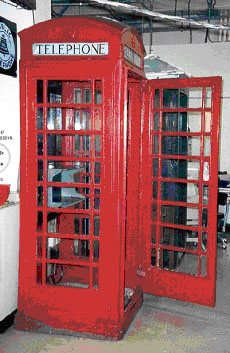 From the "Ham Shack" in Dick's basement the contact went out. Contacts with fellow Hams Paul Turnham-G4VLS and Roger Cooke-G3LDI in the UK, led to talk about the museum project Dick was involved with here in Seattle. As both were planning holiday trips to the USA, Dick and Bev invited Paul, his wife Pearl, and Roger to include Seattle on their trip. Plans were confirmed and Seattle was on each of their itineraries. A visit to the museum was a must do, must see. During the tour a dream started to take shape. A "call box" from the UK would go well and add a unique international flavor to the displays.
From the "Ham Shack" in Dick's basement the contact went out. Contacts with fellow Hams Paul Turnham-G4VLS and Roger Cooke-G3LDI in the UK, led to talk about the museum project Dick was involved with here in Seattle. As both were planning holiday trips to the USA, Dick and Bev invited Paul, his wife Pearl, and Roger to include Seattle on their trip. Plans were confirmed and Seattle was on each of their itineraries. A visit to the museum was a must do, must see. During the tour a dream started to take shape. A "call box" from the UK would go well and add a unique international flavor to the displays.
Upon return to Norwich, Paul and Roger contacted British Telecom to feel out a request for a donation of a "call box" for the Seattle museum. The idea was received and the possibility of the donation was not dismissed. A follow-up letter from the Seattle museum was sent to BTC via Paul about one year ago. Following that letter a long wait was in store. The response came to Paul and Roger from BTC's Steve Chamberlin (GOWA) and Martin Galea (G7PDO) over the local 2-meter ham repeater. BTC was donating a call box equipped with an appropriate coin collector set and where should it be delivered.
Pearl and Paul Turnham had it delivered to their home's front garden in Norwich. It became the talk of the town and a landmark. (A side note was that when the Turnhams mowed and trimmed their garden, Pearl would trim the grass surrounding the call box and then open the door and trim the grass inside.)
Now a call box was in hand, but how does one transport a 3/4 ton item from Norwich, Norfolk, England to Seattle, Washington, USA?
An American Air Force Base at Mildenhall in the nearby county of Suffolk was a possibility, as MATS aircraft flew routinely between the UK and the USA. A request went out for U.S. support in transportation, but after due consideration the U.S. Air Force flatly denied the request. Not being willing to accept defeat, Paul and Roger considered alternatives. They next sent a letter to Richard Branson of Virgin Airline as that firm operates a large airfreight business throughout the world. Sir Jimmy Saville, host or presenter of a TV show "Jim will fix it", was also contacted.
Roger and Paul discussed Paul's idea of sending a letter to No. 10 Downing Street. Roger said, "you can't send a letter to the Prime Minister" but Paul's thoughts were, " Why not? If people don't know you need help, they can't help you". A letter of request went out to John Major, British Prime Minister, for his assistance. Within three Days, "Number 10" responded to the request. The Prime Minister had contacted his Foreign Office and the British Consulate in Seattle to coordinate and expedite the Call Box Caper.
Mr. Mike Upton, British Consulate in Seattle, was given the task. A miracle worker was on the job. One of his first tasks was to verify that the whole caper was not a hoax! Sure enough, it was for real, so to work he went. Mike reviewed the transport manifests that indicate the commerce shipments from the UK to the Pacific Northwest. As if by magic he discovered the Rolls Royce Co. LTD shipped jet engines for the new Boeing 777 aircraft to the Seattle/Everett area. Mike contacted Mr. Phil Powell of Rolls for assistance and the answer was yes…yes, it would be possible to fit the call box on a flight to Seattle.
Roger and Paul had struck it rich. Now the call box was just 120 km from the Derby East Midlands airport and the trip to the USA. You don't just move the 3/4 ton red call box at the wink of your eye. So again there was a need for help in moving the call box to the East Midlands airport.
Again, Paul's thoughts, "If they don't know you need help, they can't help you." came into action. We made contact with the independent TV stations, (Anglia Television) by Jim Bacon, a fellow Ham radio operator (3YLA) hoping for coverage on the local news. They didn't have a crew available and suggested that BBC television should be contacted. BBC TV also didn't have a crew that could be dispatched promptly and suggested that BBC Radio may provide coverage. BBC Norfolk Radio did respond and did air the story using one full minute of a three-minute news update.
Shortly after that broadcast, both BBC TV and Anglia TV dispatched a filming crews and the story now was broadcast on both radio and television. Who should respond to the request after either hearing or seeing the request for help, but the RAF, Royal Air Force? RAF truck driver Corp. Julia Scarff, accompanied by RAF boom operator Corp. Paul Edwards, arrived at the Turnham's residence to make the haul to the airport. With BTC's Steve and Martin on hand, as well as entire Paul and Pearl's neighborhood, the call box was loaded and secured for the trip to the airport.
Due to the length of their trip, the Rolls Royce Company hosted the RAF folks overnight in Derby after our precious cargo had been delivered to Rolls contact Wayne Tranmer. The call box was so close to departure, but a question of customs documentation arose. Without proper documentation the call box could not be loaded for export. The problem, but not the call box, was now in the USA, here in Seattle.
Bill Gray of the Boeing Company in Seattle was the point of contact for Rolls Royce in the UK. So he was involved in the documentation concern. He contacted me to see if I had any information to share. My only available source was Paul Turnham. To the best of his recollection, the call box had shipping labels and the accompanying carton had the contents listed on the exterior of the carton as required by customs. Relaying this information to Bill, he then contacted Donna Medlen, Customs Broker at the Fritz Companies. Donna could handle the problem, but she needed my "power of attorney" to act on our behalf.
By a stroke of luck, I was on another TPA mission and just happened to stop by the Museum. The answering machine was frantically flashing. It was Bill with an urgent call for me to contact both him and Donna. Calling Bill first, I was informed that Donna needed the power of attorney and she felt the "duty" could and would be waived, but there was however, a $115 or $150 entrance fee that we would be responsible for.
My call to Donna was next. She filled me in on the need for the power of attorney and faxed me the forms to fill out. The five pages of instructions and a single page power of attorney arrived. Talk about fine print, fill in this, but not that etc., one would think this was a government form except it wasn't in triplicate! So with the form filled out, I faxed the single page back to Donna. I followed up the fax with a call to Donna and she said the form was OK!
Now the call box could and was loaded on the Anatov 124 Russian transport aircraft and on the way! ! Happiness is the East Midlands airport finally in the rear view mirror. The flight got off on schedule at 6:00 PM London time. Due to crew flight time there would be a layover in Iceland with an ETA in Seattle of 3:00 PM on Thursday, September 7th. All is well!
Keeping everyone informed is important. Checking in with Mike Upton to share status, I informed him of the entrance fee. He took the ball and contacted Donna for more information and was glad to report back that the fee had been waived. Now it was time to wait until the aircraft departure from Iceland and an update on its ETA. Thursday AM, Bill Gray confirmed the ETA of 3:00 PM touchdown in Seattle.
I had an 11:00 appointment at the museum with a film crew that was working on a 911 film. I arrived there at 10:00 am and was joined shortly after by Lois and Ron. Lois contacted as many museum crewmembers as would answer the call and set the timetable to join in if they desired. We would be leaving for Boeing field at 1:45 PM to meet up with Bill Gray.
Next Month, The Call Box Caper, Part Two - the Call Box Arrives in Seattle.
What Is It?
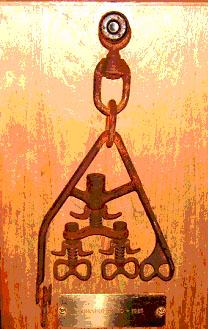 We received a request for information about this piece of equipment from one of our readers, and we are stymied. It's dropforged, and inscribed "Bell Systems Patented 1918". It's mounted on a display board that reads: "Running Board 1925." If you know what it is, please contact us at telcomhist@aol.com or on 303-296-1221.
We received a request for information about this piece of equipment from one of our readers, and we are stymied. It's dropforged, and inscribed "Bell Systems Patented 1918". It's mounted on a display board that reads: "Running Board 1925." If you know what it is, please contact us at telcomhist@aol.com or on 303-296-1221.
As always, we appreciate your continued support. I hope you and your families have a wonderful and safe summer.
© 2006 The Telecommunications History Group, Inc. All Rights Reserved.